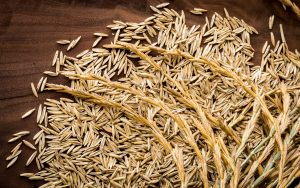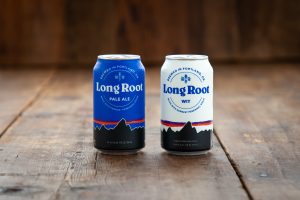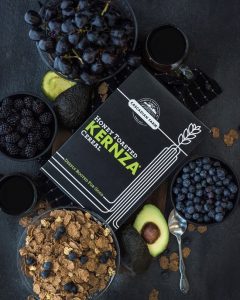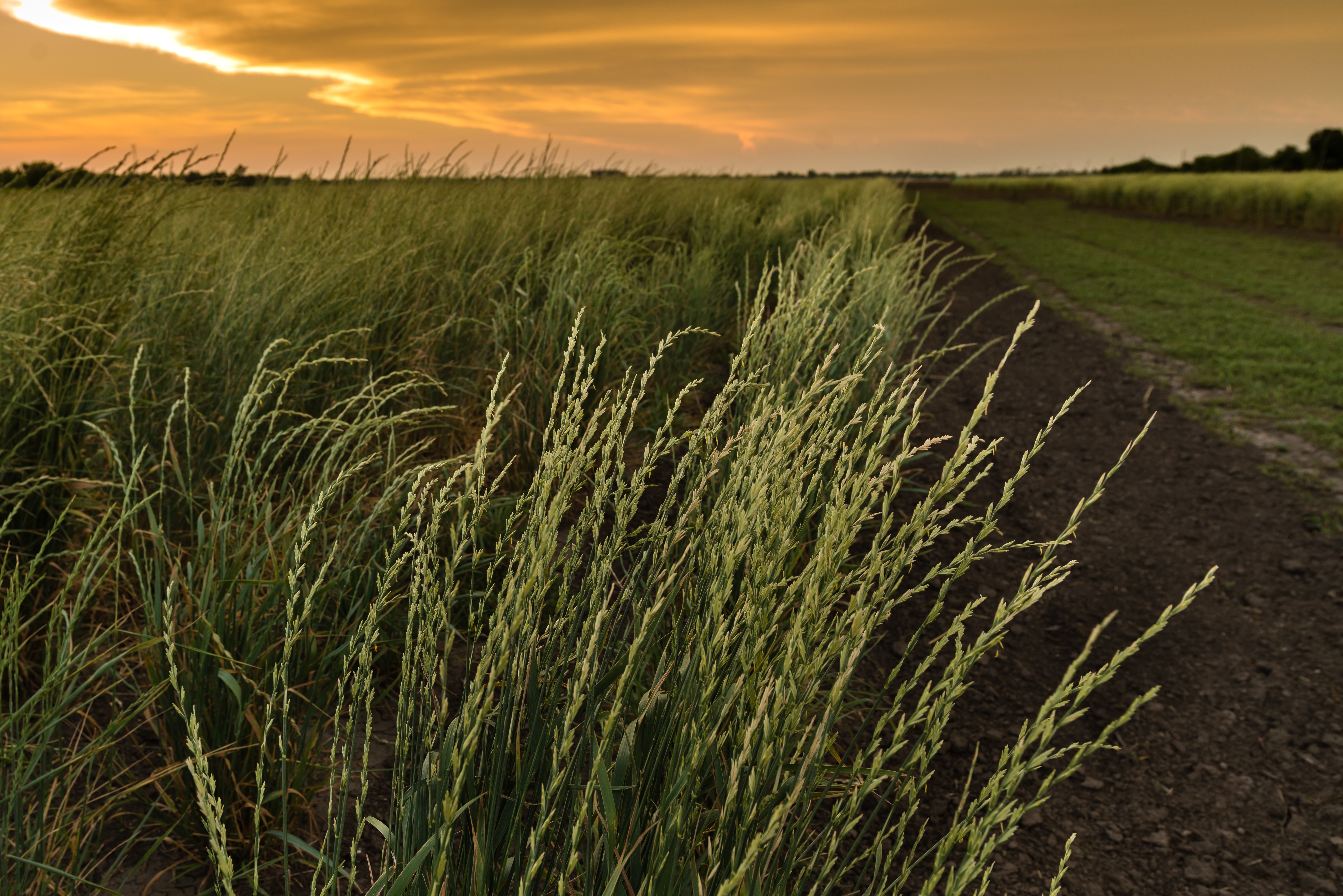
Kernza grain
It’s not often that food companies will enthusiastically adopt an ingredient without even knowing how they will use it. But that is exactly what Patagonia Provisions and General Mills have done with Kernza intermediate wheatgrass, a perennial grain that is being domesticated for food production.
Birgit Cameron, managing director, Patagonia Provisions, remembers when she first learned about Kernza in 2012.
“Yvon Chouinard (CEO of Patagonia) put a bag of Kernza on my desk and told me to go talk to Wes Jackson (founder of The Land Institute, developer of Kernza) and see if we can do something to help,” she says.

Patagonia Provisions’ Long Root Pale Ale and Long Root Wit made with Kernza perennial grain
This led Patagonia to develop the first commercial product to use the perennial crop, Long Root Ale, in 2016 and then another product, Long Root Wit, this past spring. The beers are named for Kernza’s massive 10-foot-long roots.
M.C. Comings, business unit director for organic food manufacturer Cascadian Farm, had a similar experience. In 2014, the General Mills Foundation, the philanthropic arm of the food giant, reached out to Cascadian Farm about Kernza.
“The foundation said ‘we have this grain that looks super interesting,’ ” Comings says. “We signed up to do something with it, not even knowing what.”
Today, Cascadian Farm is developing a Kernza breakfast cereal that Comings wants to see “in every grocery store in America.”
Significant potential to redirect the course of climate change
Dig a little deeper into the Kernza story, and it’s easy to understand Patagonia’s and General Mills’ enthusiasm for the perennial grain.
Kernza is the first fruit of Wes Jackson’s revolutionary vision for a perennial agriculture. Modern agriculture is based on crops planted, grown, and harvested every year. These crops, grown in large chemical-intensive monocultures of corn, soybeans, and wheat, are damaging soils, polluting waterways, and releasing greenhouse gases that fuel climate change. Not to mention creating poor quality food.
Jackson wanted to develop a completely different agricultural system based on perennial crops that grow year after year. His inspiration came from prairie plants, which stay in the ground, building healthy soils, preventing erosion, and sequestering carbon in the soil to mitigate climate change—all without the need for agricultural chemicals. Agriculture, Jackson thought, should mimic those natural prairie systems, so he founded The Land Institute to develop perennial grains and food crops.
Kernza intermediate wheatgrass is the first perennial crop to be developed by the Land Institute in partnership with Patagonia, General Mills, and the Forever Green Initiative at the University of Minnesota.
Potential to turn agriculture into a soil-forming ecosystem
Kernza promises significant environmental benefits. Because it is a perennial, farmers who grow Kernza don’t need to till or replant the crop every year, minimizing disruption to the soil. It helps reduce soil erosion and increases organic matter in the soil because of its extensive root system. It increases water infiltration to help protect surface water from runoff and sediment. Kernza also provides green cover on fields all year round.
“The length, size, and long life of the roots enable the grain to provide measurable soil health benefits and drought resistance while preventing soil erosion and storing critical nutrients—potentially turning agriculture into a soil-forming ecosystem,” says Dr. Lee DeHaan, lead scientist for the Kernza domestication program at The Land Institute.
Perhaps most importantly, Kernza has the potential to sequester carbon to help mitigate climate change. Tessa Peters, commercialization manager at the Land Institute, says research is being done to measure carbon sequestration, but “there is nothing really conclusive yet data-wise.”
“It is estimated that agriculture contributes to about 30 percent of global greenhouse emissions. It has never been more important—or more urgent—to implement farming practices that are climate-beneficial. Kernza has significant potential to redirect the course of climate change and significantly improve planet health,” DeHaan says.
Kernza will be planted at water sources in Minnesota to protect them from nitrate pollution. Corn plantings lose about 60 percent of their nitrogen, which leaches into waterways causing pollution and ultimately the massive “dead zone” in the Gulf of Mexico. By contrast, Kernza’s long roots are able to scavenge nitrogen and keep it from entering waterways.
“In one of our studies it shows up to a 98-percent reduction in nitrogen leaching compared to annual wheat. It is a really good nitrogen scavenger,” Peters says.
Farmers also benefit from growing Kernza. There is a price premium paid for the grain. It can be used for food and feed as forage or hay. Kernza helps mitigate risks for farmers, says Richard Magnusson, who grows Kernza in Roseau, Minnesota.
“This spring farmers from South Dakota to Ohio couldn’t get out into their fields to plant because of heavy rains. But if you plant Kernza on those fields you don’t have to worry about planting every year.”
No pesticides are approved for use on Kernza. The largest market for Kernza is as a certified organic crop. According to Peters, many growers are using Kernza as a transitional crop to organic.
Kernza is a registered trademark owned by The Land Institute so farmers have to sign a licensing agreement to grow it. The licensing will help with ongoing research.
“That allows us to be in touch with growers, to collect data from them, and create a database of management practices and techniques. This will help us build a grower network so that the growers can share information with one another,” Peters says.
As a food source, Kernza is high in protein and fiber. It also tastes good, says Cameron. “It provides really delicious attributes, an earthy, nutty sweetness that is another dimension beyond regular wheat.”
9984-year knowledge gap
The potential benefits of Kernza are great but much work needs to be done before it can be widely grown.
To date, about 1200 acres of Kernza have been grown in several states including Minnesota, Kansas, Illinois, and Wisconsin.
“We have a long way to go, it’s in early stages of development,” says Don Wyse, professor at the University of Minnesota and the Forever Green Initiative.
Yields of Kernza are still low. The goal is to produce Kernza grain for at least five years. But on Magnusson’s farm production peaked the first year and was very low by the third year.
DeHaan’s breeding work also aims to increase Kernza’s seed size so it is easier to harvest.
“It’s a very small grain, one-third the size of wheat so farmers who harvest it have to be really good at setting a combine (to harvest),” Peters says.
The first Kernza seed variety will be released this fall by the Forever Green Initiative. According Wyse, enough seed will be produced to plant 300,000 acres of Kernza in the next three years but the actual amount planted will depend on market demand.
“We are controlling the seed so that farmers don’t plant the seed and then don’t have a market,” he says. “The big scale-up will be determined by the market that General Mills and others create.”
The new seed variety will produce 600 pounds of Kernza per acre, which is small compared to conventional wheat’s production of 3000 to 5000 pounds per acre. The goal is to increase Kernza’s production to 2000 pounds per acre in 10 years.
There are many unknowns with Kernza. These include the right amount of nitrogen that needs to be applied, the best time to harvest, the best ways to store it, and the best regions to grow it.
“I always explain to people that wheat was domesticated 10,000 years ago,” Peters says. “The real work on developing perennial wheatgrass started in 2003. So we have a 9984-year gap to fill with our knowledge of this particular crop. Obviously there is a lot to learn.”
“More acreage we can get in the ground will be a win for everybody”
The revolutionary promise of Kernza is inspiring companies like Patagonia Provisions and Cascadian Farm to overcome the challenges.
When Birgit Cameron visited Wes Jackson at The Land Institute he told her they were 20 years away from using it in food products. But she was able to convince him they were far enough along to allow Patagonia Provisions to make a product, which led to the development of the Long Root ales.
Patagonia Provisions also plans to use Kernza in baked goods and cereal products.
“We want to show how versatile it can be beyond beer,” says Cameron.
Cameron wants to see other food and beverage companies also use Kernza, which she describes as a “meaningful ingredient.”
“We want to inspire usage by other companies so they can see the attributes as something that works. Scaling Kernza is important for the environmental benefits. The more acreage we can get in the ground will be a win for everybody,” Cameron says.

Cascadian Farm’s Honey Toasted Kernza
Cascadian Farm has a similar strong commitment to Kernza, having worked with The Land Institute and the Forever Green Initiative to research the viability of Kernza since 2014. In 2017, General Mills approved a donation of $500,000 to support advanced agricultural research on Kernza and its ability to reduce greenhouse gas emissions.
“We didn’t know what we were going to do with Kernza but it felt so aligned with our values as a brand; things that are good for people with all the benefits of organic and also good for the planet,” Comings says.
Cascadian Farm developed a breakfast cereal, Honey Toasted Kernza, aiming to sell it this year in natural food stores such as Whole Foods. But their Kernza crop suffered a crop failure due to mold, which shelved that plan. Instead, Cascadian Farm made 6,000 boxes of the cereal and sold them for $25 each as a fund-raiser for The Land Institute.
Comings describes Honey Toasted Kernza as “possibly the most important box of cereal Cascadian Farm has ever made.”
“The benefits of Kernza have incredible promise to redirect the course of climate change and significantly improve planet health. And the fact that there is a product made from it that you can hold in your hand and eat is exciting and kind of miraculous.”









